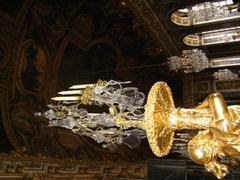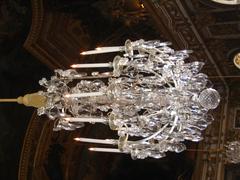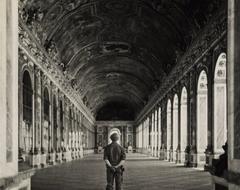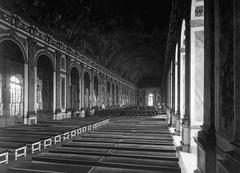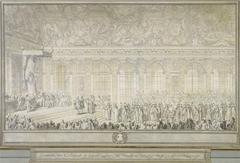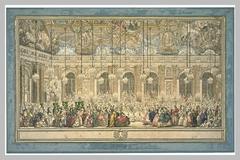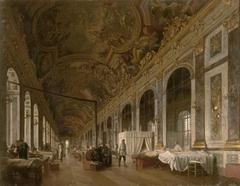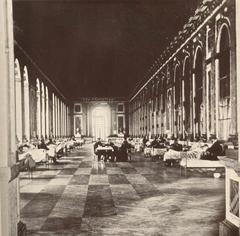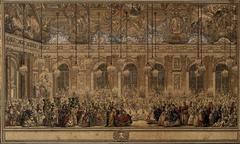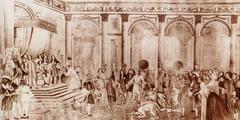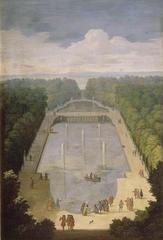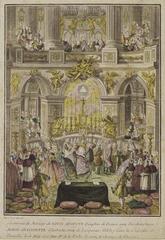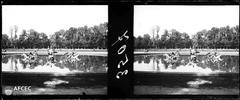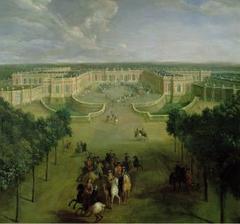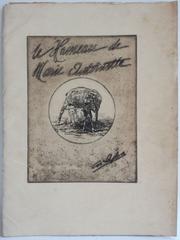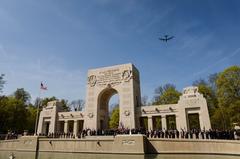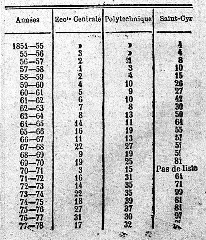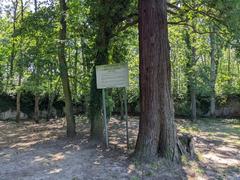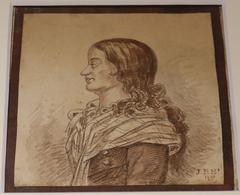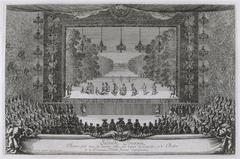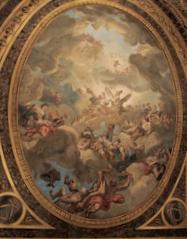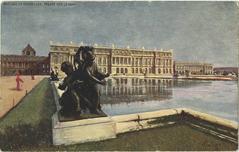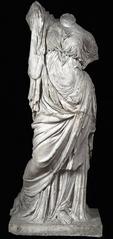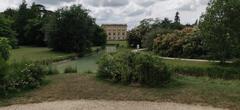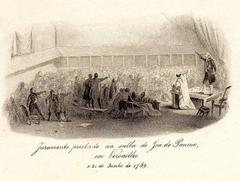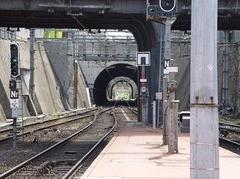
Hall of Mirrors Versailles Visitor Guide
Published Date: 17/08/2024
Introduction to the Hall of Mirrors
The Hall of Mirrors, or “Galerie des Glaces,” stands as one of the most emblematic and historically significant rooms within the Palace of Versailles. This grand gallery is not only an architectural marvel but also a canvas of political propaganda and a witness to pivotal moments in world history. Designed by the architect Jules Hardouin-Mansart and decorated by the painter Charles Le Brun, the Hall of Mirrors was constructed between 1678 and 1684 to replace an impractical terrace that separated the King’s and Queen’s apartments (Paris Digest). The Hall’s 73-meter length, adorned with 357 mirrors, reflects the opulence and grandeur of Louis XIV, the Sun King, and serves as a symbol of his absolute power (Wikipedia).
Beyond its architectural splendor, the Hall of Mirrors has been the backdrop for significant historical events, including the proclamation of the German Empire in 1871 and the signing of the Treaty of Versailles in 1919, which ended World War I (Grunge). Today, the Hall continues to captivate visitors from around the world, drawing millions annually to marvel at its artistic and historical significance. This guide aims to provide a comprehensive overview of the Hall of Mirrors, detailing its history, visitor information, and tips to ensure a memorable visit.
Contents Overview
- Introduction
- History of the Hall of Mirrors
- Construction and Design
- Symbolism and Artistic Elements
- Historical Events
- Restoration and Modern Use
- Visitor Information
- Tickets and Visiting Hours
- Guided Tours
- Special Events
- Travel Tips and Accessibility
- FAQ Section
- Conclusion
History of the Hall of Mirrors
Construction and Design
The Hall of Mirrors, known in French as the “Galerie des Glaces,” is one of the most iconic rooms in the Palace of Versailles. Its construction began in 1678 and was completed in 1684. The Hall was designed by the architect Jules Hardouin-Mansart and decorated by the painter Charles Le Brun. This grand gallery replaced a terrace that originally separated the apartments of the King from those of the Queen, which was considered impractical and exposed to the elements (Paris Digest).
The Hall of Mirrors was intended to be a symbol of the power and grandeur of Louis XIV, the Sun King. The gallery measures 73 meters in length, 10.5 meters in width, and 12.3 meters in height. It features 17 mirror-clad arches that reflect the 17 windows overlooking the gardens of Versailles. Each arch contains 21 mirrors, totaling 357 mirrors (Wikipedia).
Symbolism and Artistic Elements
The Hall of Mirrors is not just an architectural marvel but also a canvas for political propaganda. The ceiling, painted by Charles Le Brun, is adorned with 30 allegorical paintings that celebrate the political and military achievements of Louis XIV. The central panel, titled “The King Governs Alone,” symbolizes the establishment of Louis XIV’s personal reign in 1661. Other panels depict various military victories, from the Treaty of the Pyrenees in 1659 to the Treaty of Nijmegen in 1678-1679 (Paris Digest).
The mirrors themselves were a significant technological and artistic achievement. At the time, Venice held a monopoly on mirror manufacturing. The creation of the Hall of Mirrors marked a defiance of this monopoly and showcased French manufacturing prowess. The mirrors became a symbol of French luxury and the birth of major national industries such as Lyon silks, Gobelins tapestries, and Saint-Gobain glassworks (Grunge).
Historical Events
The Hall of Mirrors has been the backdrop for several significant historical events. One of the most notable events was the proclamation of the German Empire on January 18, 1871, by Otto von Bismarck, following the French defeat in the Franco-Prussian War. This event marked the unification of Germany and was a moment of great humiliation for France (Paris Digest).
Another pivotal moment in history that took place in the Hall of Mirrors was the signing of the Treaty of Versailles on June 28, 1919. This treaty officially ended World War I and imposed heavy reparations and territorial losses on Germany. The choice of the Hall of Mirrors for the signing was symbolic, as it was the same location where the German Empire had been proclaimed 48 years earlier (Grunge).
Restoration and Modern Use
The Hall of Mirrors underwent a significant restoration that was completed in 2007. This $16 million project was the largest example of corporate cultural sponsorship in France at the time. The restoration aimed to preserve the hall’s historical integrity while cleaning and repairing its many elements. Notably, 48 of the 357 mirrors were replaced, while the rest were carefully cleaned and restored. Approximately 60% of the mirrors date back to the time of Louis XIV (Grunge).
Today, the Hall of Mirrors continues to serve as a venue for state functions and receptions. French political leaders often welcome esteemed guests in this lavish room, showcasing the grandeur of French history and architecture. The hall remains a symbol of France’s political, economic, and artistic success (Grunge).
Visitor Information
Tickets and Visiting Hours
Visiting the Hall of Mirrors requires a ticket to the Palace of Versailles. Tickets can be purchased online or at the palace entrance. It is advisable to book tickets in advance to avoid long queues. The Palace of Versailles is open every day except Mondays. The visiting hours are from 9:00 AM to 6:30 PM, with the last entry at 6:00 PM during the high season (April to October). During the low season (November to March), the palace closes at 5:30 PM with the last entry at 5:00 PM (Descubre Paris).
Guided Tours
Guided tours of the Hall of Mirrors are available and provide a more in-depth understanding of its history and significance. These tours are offered in both English and French and can be booked directly at the palace or online. A guided tour can enhance your experience by providing detailed insights into the architectural and artistic elements of the hall.
Special Events
The Palace of Versailles hosts various thematic events, such as the nighttime Musical Fountain Shows and the Royal Serenade, which offer unique ways to experience the grandeur of the Hall of Mirrors and the palace grounds. These events are highly popular and require separate tickets, so it is recommended to book in advance.
Travel Tips and Accessibility
For those planning to visit the Hall of Mirrors, it is advisable to go during the off-season or on weekdays to avoid the large crowds. The hall is one of the most popular attractions in the Palace of Versailles, and it can get very crowded, especially during peak tourist seasons. Visitors should plan their return to Paris carefully, as public transportation options may be limited after special events.
The palace is accessible to visitors with reduced mobility. Wheelchairs are available at the entrance, and there are elevators to access the Hall of Mirrors and other parts of the palace.
FAQ Section
Q: How long does it take to visit the Hall of Mirrors? A: A visit to the Hall of Mirrors typically takes around 30 minutes to an hour, depending on the crowd and your interest in the details.
Q: Are there any discounts on tickets? A: Yes, discounts are available for students, children, and senior citizens. It is advisable to check the official Palace of Versailles website for the most up-to-date information on ticket prices and discounts.
Q: Can I take photographs inside the Hall of Mirrors? A: Yes, photography is allowed inside the Hall of Mirrors, but the use of flash and tripods is prohibited to preserve the artworks.
Conclusion
In summary, the Hall of Mirrors is not just a room but a historical monument that encapsulates the grandeur, power, and artistic achievements of France during the reign of Louis XIV. Its mirrors, paintings, and architectural design continue to captivate visitors from around the world, making it a must-see attraction in the Palace of Versailles.
Credible Sources and Further Reading
- Paris Digest. Hall of Mirrors. Retrieved from Paris Digest
- Wikipedia. Hall of Mirrors. Retrieved from Wikipedia
- Grunge. What You Should Know About the Palace of Versailles Hall of Mirrors. Retrieved from Grunge
- Descubre Paris. What You Should Know Before Visiting the Palace of Versailles. Retrieved from Descubre Paris
- Snippets of Paris. Hall of Mirrors at Versailles. Retrieved from Snippets of Paris
- Chateau Versailles. The Hall of Mirrors. Retrieved from Chateau Versailles
- Versailles Tourism. The Hall of Mirrors. Retrieved from Versailles Tourism
- Salut from Paris. Day Trip to Versailles. Retrieved from Salut from Paris
- Earth Trekkers. How to Visit Versailles. Retrieved from Earth Trekkers
- CleverlySMART. Hall of Mirrors Galerie des Glaces at the Palace of Versailles. Retrieved from CleverlySMART
- European Traveler. Tips on Visiting the Musical Fountain Show at the Palace of Versailles. Retrieved from European Traveler
- Headout. Hall of Mirrors Versailles. Retrieved from Headout
- Tourist Secrets. The Palace of Versailles: A Complete Guide to Visiting. Retrieved from Tourist Secrets
- Get Lost in Wanderlust. Versailles in Winter. Retrieved from Get Lost in Wanderlust
- Tiqets. Retrieved from Tiqets
- GetYourGuide. Retrieved from GetYourGuide

